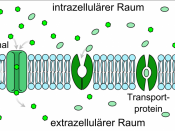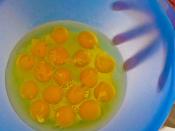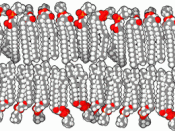9.1 PLASMA MEMBRANE
I. All cells must maintain homeostasis in order to live.
- they do this by controlling what materials can enter and leave
II. All cells have a plasma membrane that is SELECTIVELY PERMEABLE - this only allows for specific things to enter and leave the cell
A. Selective permeability is achieved by the structure of the plasma membrane (fig.9.3, pg 220)
1. The cell membrane is composed of 2 layers of PHOSPHOLIPIDS -
"phospho" = phosphate "lipid" = fat
÷ referred to as the "phospholipid bilayer"
÷ phospholipids have polar, water-soluble heads attached to long, nonpolar tails.
÷ The phosphate heads are on the outside and the inside of the cell
÷ The nonpolar tails lie inside the bilayer
B. The phospholipids can move sideways through their layer - this allows the membrane to behave like a fluid, it can flow.
÷ FLUID MOSIAC MODEL
÷ Other organelles surrounded by a fluid mosiac bilayer include: the nucleus, vacuoles, mitochondria and chloroplasts.
C. Throughout the membrane, proteins are found between the phospholipid molecules
÷ these proteins carry out most of the functions of the p. membrane
- they determine which particles can pass across the membrane
- some proteins act as enzymes (speed up reactions or processes)
- other proteins act as markers that are recognized by chemicals from both the inside and outside of the cell. Some of these markers are involved in fighting disease
9.2 CELLULAR TRANSPORT - the moving of particles across a cellular membrane
I. Brownian Movement (Robert Brown)
- random movement of particles
II. Diffusion - movement of particles from an area of high concentration to an area of low
concentration
÷ tries to balance the concentrations in and outside of the cell - put into equilibrium
÷ differences in concentrations across a...


